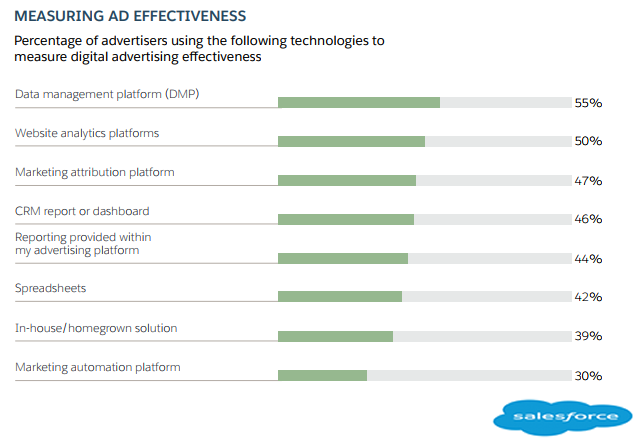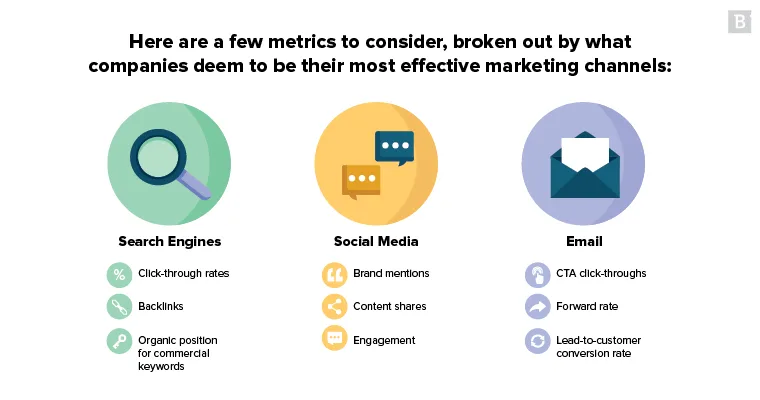To measure the effectiveness of digital advertising, track metrics such as click-through rate (CTR) and return on investment (ROI). Analyzing conversion rates and cost per acquisition (CPA) also provides insight into an ad’s impact.
Understanding the success of digital advertising campaigns is critical in the dynamic online marketing landscape. Advertisers must pinpoint which strategies yield results and which need refinement. Measuring effectiveness goes beyond traditional analytics; it involves diving deep into data that reveals consumer behavior and campaign performance.
Marketers examine various indicators to ascertain whether their ads resonate with the target audience. Key performance indicators (KPIs) like CTR, ROI, CPA, engagement rates, and customer lifetime value (CLV) are instrumental in evaluating the potency of digital ads. By leveraging analytics platforms and attribution models, businesses can accurately gauge the effectiveness of their digital advertising efforts, enabling them to make data-driven decisions to optimize their marketing strategies and maximize their budgets.

Credit: www.digitalmarketingcommunity.com
Introduction To Digital Advertising Metrics
Understanding the impact of your digital ads is crucial. Introduction to Digital Advertising Metrics is your starting point. It guides you through the data maze. Learning what to track can make or break your online strategy. Here, we explore why metrics matter and which ones you should focus on.
The Importance Of Tracking Performance
Performance tracking is vital to judge your digital advertising’s success. Without it, you’re in the dark. Analyzing the right metrics allows for data-driven decisions. These insights help refine campaigns and boost ROI. Let’s see which metrics offer the clearest picture of your ad’s impact.
Key Performance Indicators (kpis) For Digital Advertising
KPIs are your performance compass. They direct your efforts towards real results. We’ll uncover crucial benchmarks that shed light on how well your ads do.
- Click-Through Rate (CTR): Percentage of viewers who click on your ad.
- Conversion Rate: How often a click leads to a desired action, like a sale.
- Cost per Acquisition (CPA): The price you pay for each conversion.
- Return on Ad Spend (ROAS): Measures the revenue generated for every dollar spent on advertising.
- Bounce Rate: Visitors who leave quickly after clicking your ad.
These KPIs represent just a glimpse of what’s necessary for effective ad measurement. We will dive into each metric in the sections that follow.
Setting Your Campaign Goals
Setting Your Campaign Goals is the cornerstone of success in digital advertising. Clear goals guide your strategy, influencing your choice of platform and ad format. They also provide a benchmark to measure against. Let’s explore how to set the right goals for your campaign’s triumph.
Determining Your Business Objectives
Begin by pinpointing exactly what your business aims to achieve with digital advertising. Is it more website traffic, increased sales, or brand awareness? Setting clear, achievable objectives provides a foundation for your advertising efforts.
- Boost Sales: Accelerate product or service sales through targeted campaigns.
- Enhance Brand Visibility: Reach more potential customers to foster brand recognition.
- Increase Engagement: Encourage more interactions with your brand online.
- Grow Traffic: Drive a higher volume of visitors to your website or landing pages.
Aligning Goals With Kpis
Key Performance Indicators (KPIs) are vital in tracking progress. They must align with the objectives you have set. For sales goals, conversion rate is a primary KPI. For brand awareness, track impressions and reach.
| Objective | Primary KPI |
|---|---|
| Boost Sales | Conversion Rate |
| Enhance Brand Visibility | Impressions, Reach |
| Increase Engagement | Click-Through Rate (CTR), Social Interactions |
| Grow Traffic | New vs. Returning Visitors, Page Views |
Tools And Platforms For Tracking
Welcome to the era of data-driven decision-making in digital advertising. Knowing how your ads perform is crucial. Good tools make this easier. Let’s explore these tools.
Using Analytics Software
Analytics software tracks your digital ad performance. Look for features like:
- User engagement: Time on site and pages visited.
- Conversion tracking: Who buys after clicking an ad.
- Traffic sources: Where your visitors come from.
Google Analytics is a popular choice. It’s detailed and free. Set it up to see how ads lead to sales.
Leveraging Ad Network Dashboards
Ad networks provide dashboards. These show how ads perform. Key metrics include:
| Click-Through Rate (CTR) | Impressions | Cost Per Click (CPC) |
|---|---|---|
| Clicks relative to impressions | Times your ad is shown | The price of each ad click |
Tools like Facebook Ads Manager and Google Ads offer these insights. They help optimize ad spend.

Credit: www.lucidadvertising.com
Evaluating Key Metrics
To truly understand the success of your digital advertising efforts, you need to dive deep into the data. Key metrics shed light on campaign performance and inform decision-making. Grasping these metrics ensures marketing budgets are used effectively.
Click-through Rate (ctr) And Its Significance
CTR is a crucial gauge for assessing how well your ads resonate with your audience. It’s calculated by dividing the number of clicks by the number of impressions
CTR = (Clicks ÷ Impressions) × 100%
A high CTR indicates that your ad is relevant and engaging to viewers, leading them to want more information.
Understanding Conversion Rates
Conversion rates are the backbone of digital ad success. They tell you what percentage of clicks turn into desired actions, like sales or sign-ups.
- Track conversions through analytics tools.
- Adjust campaigns based on what’s converting best.
The Role Of Cost Per Click (cpc)
CPC measures how much you pay for each click on your ads. It’s pivotal for budget management.
Calculate CPC by dividing the total cost of your clicks by the number of clicks.
CPC = Total Cost of Clicks ÷ Number of Clicks
A lower CPC means you’re getting more value for your spend.
Viewability And Impression Share
Viewability refers to whether ads are actually seen by users, while impression share reflects the percentage of impressions your ads receive compared to the total number they could get.
- High viewability
- means your ads are in visible spots.
- Impression share
- indicates market reach.
These metrics help fine-tune ad placement and exposure to enhance campaign effectiveness.
Optimizing Campaigns Based On Data
Optimizing Campaigns Based on Data is crucial for digital advertisers seeking to harness the full potential of their online efforts. By analyzing performance metrics, advertisers can tweak their strategies for better outcomes. This process involves continuous testing, learning from data, and adjusting the approach to enhance return on investment (ROI). Let’s dive into the techniques that make this possible.
A/b Testing For Improved Outcomes
A/B testing, also known as split testing, is a powerful strategy to optimize digital advertising campaigns. It involves comparing two versions of a campaign to determine which performs better. This method provides concrete data on which elements are most effective.
- Test different headlines to see which generates more clicks.
- Experiment with images to determine which drives higher engagement.
- Assess call-to-action buttons for conversion rate variations.
By implementing regular A/B tests, advertisers can continually refine their campaigns for improved performance.
Making Data-driven Decisions
Data is the compass that guides digital advertising strategy. Insights gathered from analytics tools inform decisions that can lead to more effective campaigns. Focus on key performance indicators (KPIs) such as click-through rates (CTR), conversion rates, and cost per acquisition (CPA) to make informed adjustments.
- Analyze data trends over time to spot patterns.
- Use audience insights to tailor ad content.
- Adjust budgets based on campaign performance data.
With a data-centric approach, decisions are not based on hunches but on proven analytics.
Adjusting Strategies For Maximum Roi
To maximize ROI, advertisers must be willing to adjust their strategies based on data insights. This means being agile enough to shift budget allocations from underperforming channels to those with a higher conversion rate.
| Before Optimization | After Optimization |
|---|---|
| Lower ROI on Channel A | Higher conversion rate on Channel B |
| Excessive budget on Channel C | Reallocation of funds to Channel D |
Regularly revisiting campaign strategies to incorporate fresh data ensures that every dollar spent is an investment towards higher returns.

Credit: www.insiderintelligence.com
Frequently Asked Questions Of How To Measure Effectiveness Of Digital Advertising
What Are Key Metrics For Digital Ad Effectiveness?
Key metrics for measuring digital advertising effectiveness include Click-Through Rate (CTR), Conversion Rate, Return on Ad Spend (ROAS), and Cost Per Acquisition (CPA). These indicators help advertisers evaluate campaign performance and optimize strategies.
How Does Engagement Impact Digital Ad Success?
Engagement signals user interest and can boost ad relevance and performance. Metrics such as time on page, social shares, and comments are indicative of engagement. High engagement typically correlates with increased conversions and brand affinity.
Can Analytics Tools Track Digital Ad Performance?
Yes, analytics tools like Google Analytics can track digital ad performance. They provide insights into user behavior, campaign conversion rates, and website traffic sources, all essential for measuring the effectiveness of digital advertising efforts.
Why Is A/b Testing Important For Digital Ads?
A/B testing is important because it allows advertisers to compare different ad variants to determine which performs best. This data-driven approach leads to better decision-making and more effective advertising strategies by identifying successful elements.
Conclusion
Understanding the success of digital advertising campaigns is key to optimizing your marketing efforts. By embracing analytics, utilizing A/B testing, monitoring conversion rates, and tracking customer engagement, you take control of your ad performance. Remember, the insights gained will empower your strategies, ensuring your advertising investment delivers optimal results.
Keep learning, keep testing, and stay ahead in the digital advertising game.









